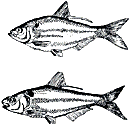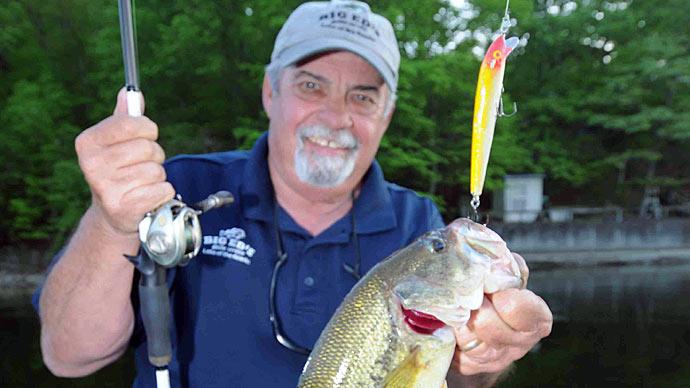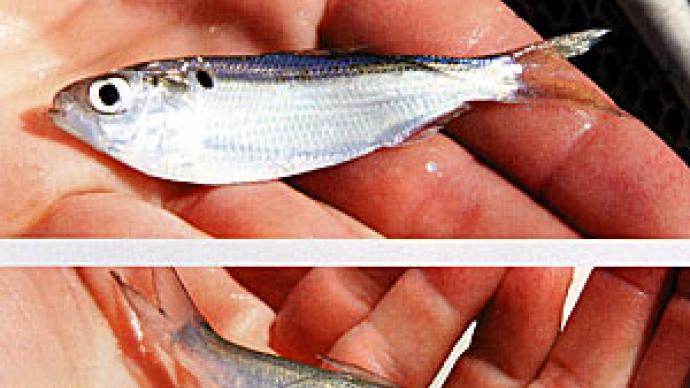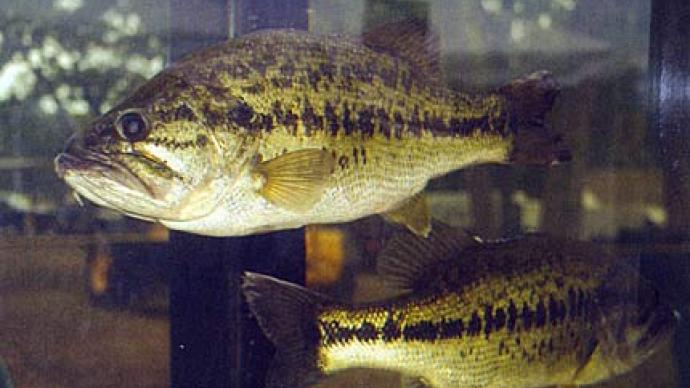
The hatchery phone rings. A male voice has a question. "How much are your fathead minnows?" The perplexed fellow wants to buy forage fish, or thinks he does. From my 20-plus years of managing ponds in Arkansas, Louisiana, Texas and Oklahoma, I know he does not want to buy fatheads. Almost certainly, he will be better off stocking a different species. He just doesn't realize it yet.
I start the pond owner's cram course in the basics of the forage base, with a question: "What kind of project are you working on?"
"I own a 7-acre lake, my bass are skinny, and all I catch are fish about a pound apiece."
Aha ... As I expected ... A pond that has all the earmarks of a system overloaded with predators. The urgent, almost apologetic tone of his voice begs for more info.
"Underweight bass? How can I tell?"
I start throwing out more questions, such as what do the fish have to eat? What's their length, compared to the their weight? How old are these undernourished bass? How old is the lake? What's the stocking and fishing history of his puddle? Is there a fertilization program? Does he add supplemental feed to the pond? What about harvest? Does he have a set of bag limits for anglers?
Over the phone, we work our way through a primer in the role forage fish play in his pond. From these ABC'S, I can make the caller literate in basic pond management.
If this sounds familiar, it should. I can't tell you how many times this phone call has come through out switchboard over the past 20 years. Different people, from different states, asking the same questions, over and over.
POND BOSS Editor Mark McDonald tells me that complaints about skinny bass rank No. 2, second only to runaway vegetation, on the list of challenges facing the amateur pond owner. From Michigan to Alabama, Carolina to California, the problem and the solution are virtually the same.
First, make sure you actually have a forage fish problem. If a new lake has been stocked properly in the beginning, there may not be a forage problem. It could be a fishing problem. Evaluate, and learn to tell the difference. Here's how:
Stocked correctly, forage fish in a new start-up explode in number. Bass come later, and when they arrive in their new home, they grow like a sumo wrestler locked in a Wendy's.
But, as bass in the original stocking grow, then spawn, dynamics change. More bass, feeding on a finite amount of food, begin to miss meals. Individual growth-rate slows, even though, all told, the pond may be producing more pounds of fish than it did a year before.
Monitoring bass growth-rates tells pond managers when to selectively harvest fish, and what size ranges to take. Catching a few predators keeps the dynamics fresh, and the food chain expanding. Catch and release is the very watchword of a balanced fishery, but practicing it blindly, for too long, may lead to a downturn. Bass will lose weight.
Too many times we hear from lake owners whose bass are grossly underweight. So what does the pond owner do? He gets a couple bass fishing buddies to catch a few 5-pounders at the nearest public reservoir and move them to his pond -- adding to the problem of overcrowding.
In virtually every case, my crew can go out and inspect the pond and discover that forage fish are in low number, or they don't exist. Gone. The bass population survives through the year only by eating its own spawn.
So consider the root of the problem -- too many hogs at the trough - - and take steps to solve it. Remove some bass. Not enough forage fish? Add some, then manage them.
Which forage species do you stock.? And in what number? We'll get to that, right quick. But first, back to the phone call ...
The poor guy started this frustrating trek by calling his local county extension agent. The agent knows a lot more about cows than he does fish, so he passed off the caller by handing him a list of local fish hatcheries and dealers. All our man wants is a few fish. Hatchery No. 1 tells him to stock fathead minnows, at the rate of five pounds per surface acre, at $10 a pound. Our would-be pondmeister shrugs and dials a fellow at Hatchery No. 2, then Hatchery 3. The last two spend more time bad-mouthing their competitors than talking about fish.
Stock adult bluegills, says one. Stock shiners, says another. Stock fatheads, golden shiners, threadfin shad, goldfish and, presumably, the kitchen sink.
By now, out man is totally confused. Prices. Stocking rates. Stocker fingerlings. Adult brooders. The blur was giving him a headache, until, as a last resort, he phoned our office. We begin solving the problem by recommending bluegill. These blue-collar fish may not be too glamorous, but for most North American ponds (save for those at elevation) they serve as the backbone of the fishery, the mainstay of the food chain.
The bluegill is the perfect baitfish, with a mouth smaller than a pencil eraser, so it can not compete with adult bass for food. Like underwater rabbits, bluegill spawn several times a year adding pint-sized food to the system every time.
In northern waters, bluegill commonly spawn two to three times before the growing season ends in mid-October or so. In Dixie, the pan-shaped creatures may create little craters in the shallows and spawn as many as four times in a calendar year, depending on the severity of the winter.
Bluegill set the table for the success of most bass lakes. Look at numbers.
A female bluegill may lay as many as 2,500 eggs per spawn. One brood male has the ability to incubate a nest of eggs that may have been dropped by several females. So, given these spawning dynamics, how can a pond with bluegill ever have skinny bass?
Answer.- It takes up to 10 pounds of forage fish for one bass to gain one pound. The more bass you have, obviously the more forage they require. And you want your baitfish to supply forage in a wide variety of sizes.
So it becomes a balancing act ... Adult bluegill, too large to be eaten by most bass, cranking out baby bluegill so the buffet line will stay open 24 hours a day.
Stocking rate: Use 200 adults per surface acre for a pond with no existing bluegill population.
Advanced tip: Manage your pond for bluegill, and your predator fish will flourish, too. Fertilize on schedule if needed, to produce plankton- rich water and dense cover.
Stock adult bluegill in early spring, no earlier than late February, give them time to get accustomed to the new surroundings, but not so early that large bass can eat them quickly. The objective is for the bluegill to spawn, spawn, spawn. These principles do not apply to the minnow species.

Fathead minnows spawn continually during warm months, but are too small and too slow to escape the maw of hungry bass. Put in 10 pounds of these creatures, and the adult bass in the existing population get a quick snack. An expensive one, to boot.
In an established pond with bass or trout, fathead survival rate is so low, they are simply a quick, expensive meal. Use fatheads in new ponds only, to prepare for bass fingerlings, not adults.
Stocking rate: In a new pond, use five pounds per surface acre, along,with bluegill fingerlings up to 1000 per acre.
Advanced tip: Fatheads stick their eggs on the underneath side of firm objects, so encourage their reproduction by adding wooden pallets, PVC pipe, old tires, rocks or docks to shallow water areas. When you see a nest the size of an old 50-cent piece, you know your fatheads are busy.
Golden shiners are sometimes used as supplemental stocking in ponds where water levels may draw down in the winter. These sleek, fast-swimming minnows have the physical tools to escape predation, and survive long enough to spawn, but reproduce only once yearly.
Shiners, then, are predators that may compete with bass, but they are limited by mouth size. Use these fish only after choosing carefully your course of action.
Stocking rate: Depending on time of year, and condition of the pond, stock as few as five pounds per acre, as many as 50. If you're looking for giant bass, I would lean toward the higher stocking rate.
Advanced tip: Each spring, shiners like to stick their eggs on grass at the water's edge. Commercial minnow hatcheries use a device that looks like the pad from an old-fashioned evaporative cooler. You may substitute Bermuda grass hay, broken up and distributed around the water's edge in early April.
Another hint . . . Buy shiners when eggs are almost ready, usually in late March or early April. Ask your fish dealer or hatchery to be on the lookout for "eggy" fish.
Red horse minnows, spot-tailed minnows, silver-sides and other species of native minnows can be used.
As for the sunfish species, redear sunfish ("shellcracker," or "stumpknocker") operate harmoniously with bluegill, but should not be considered a replacement for bluegill, but good insurance.
Redear feed in a different niche than other fish, primarily dining on snails and other crunchy creatures in the pond. Redears spawn just a little earlier than bluegill, when water temps are pushing the mid-60's.
Redears bring more forage fish to the table during busy spring months, when bass are recovering from winter. Better yet, redears grow larger than a pound, can survive in a system with adult bass, so this can be a good fish to add to the mix, especially in warm, southern and southeastern waters. Redears can not tolerate cold water temperatures.
Hatcheries may offer another 10-15 species of sunfish. Socalled "hybrid green sunfish" are readily available at competitive prices, simply because they are easy to haul.
Hybrid sunfish are promoted by some hatcheries, bragging the fish will grow up to five pounds. In 20 years, the biggest I have seen pushed the scales to 3/4 pound.
Simply put, I have found hybrid green sunfish to be totally inferior to the native bluegill in both spawning capacity and growth-rate. Consequently, I don't recommend using hybrid greens, nor do I suggest stocking pumpkinseeds, orange-spotted sunfish, long ear, or any other native species of sunfish. They don't spawn enough, or grow large.
Shad? There are two species common to U.S. waters, gizzard and threadfin. Shad are typically filter feeders, gleaning microscopic critters from the water column, funneling food straight into a long stomach. Both species of shad like open water, and must continually swim, or sink into oblivion. They do not have air bladders, so they can't regulate up and down like most fish.
Gizzards spawn once annually, grow fast, get large -- up to 2 pounds. An adult gizzard shad female can lay as many as 250,000 eggs a year. These fish produce low hatch-rates, low survival, but still strong enough to be significant.
Gizzard shad are hearty in most climates, even ice cover, as long as oxygen is plentiful. The down side? If you don't have enough large bass to eat fast growing shad, these silver- sided creatures can grow too big, too fast to accommodate average size bass.
If you feed your fish with a high-protein supplement, watch for gizzards to gather in schools and chow down on the small pellets. Unfortunately, they may out compete your bluegill.
Threadfins are different. A seven-incher is huge, but watch them die when water temperatures fall below 42 degrees. But, these high-RPM fish are love machines.
Spawning continually through warm months, threadfin shad have the equipment and metabolism rate to reproduce exponentially. They stick eggs on underwater grass, each shad spawning every 40-60 days, depending on temperature.
Baby shad mature and spawn at 60 days of age. If the water is fertile, and they are not eaten by adult bass, they will continue to spawn until temperatures drop in the autumn, supplementing the bluegill crop. Good stuff, especially in trophy bass lakes. Threadfins, in the right part of the world, are outstanding forage fish to supplement bluegill.
Stocking rate: In new lakes, stock 200 threadfin per acre. In reservoirs with established predator populations, the fishery will require more threadfins before they "take." This rate could be as high as 2,000 per acre, depending on water conditions and numbers of bass to eat the little critters.
Advanced tip: Order threadfins early. Contact the hatchery, place your order in the fall, for spring delivery. Then, in springtime, watch water temperatures closely, and when the temp is consistently above 60 degrees, fertilize the water on schedule, as needed.
Have the shad delivered when water is fertile, and plankton is plentiful. And, don't forget, make sure they have a place to spawn. As for gizzard shad ... Stocking rate: Use 30 adults, at least 12" long, per acre, in late winter, very early spring.
Advanced tip: Buy large gizzard shad, and caution the fish-hauler about getting greedy. Large gizzards can not tolerate overcrowding and should be hauled with only 25-50 adults per hauling compartment. Move them quickly during cool water months.
Big shad lay lots of eggs, so you don't need many to establish a population.
As you work your management plan, monitor the growth-rates of your bass and modify your forage selectively. You will make your decisions more effectively if you know how each forage species lives, eats and reproduces.
What did the caller do? He used earthworms and a bobber to fish for bluegill. Didn't catch a one.
So I got him to stock 200 adult bluegill (3-plus inches in length) per acre, started a feeding program with high-protein pellets. He fertilizes once or twice a year, and removes all bass he catches that are 14 inches or shorter, unless he catches a fat one.
As a result, when we talk now he has confidence in his voice. A lake full of big bluegill and fast-growing, healthy bass will do that for you.
Veteran fisheries biologist Bob Lusk runs Texoma Hatchery pond consulting service. He may be reached at 903-564-5372. His new book, "Raising Trophy Bass," may be purchased by calling 800-687-6075.
Reprinted with permission from Pond Boss Magazine



